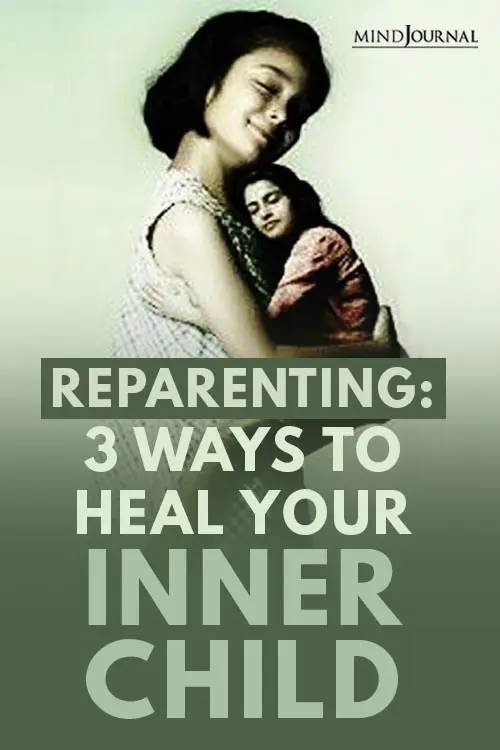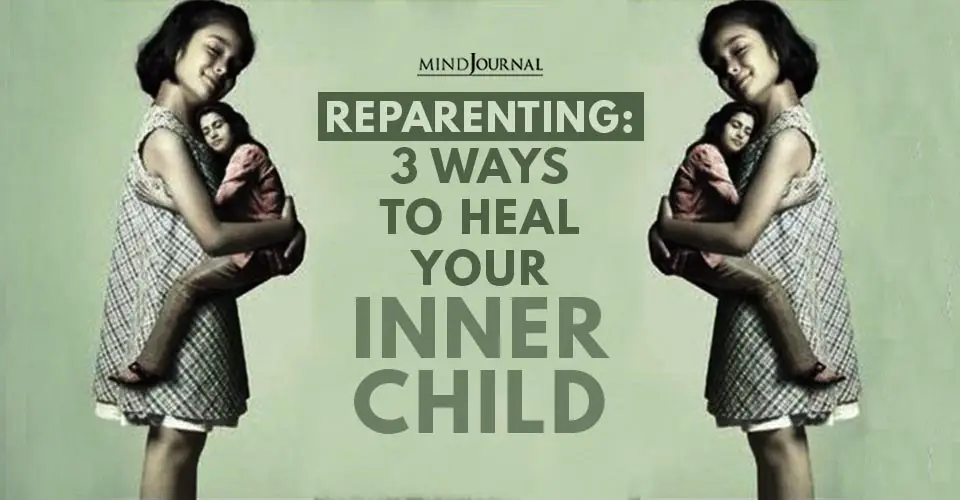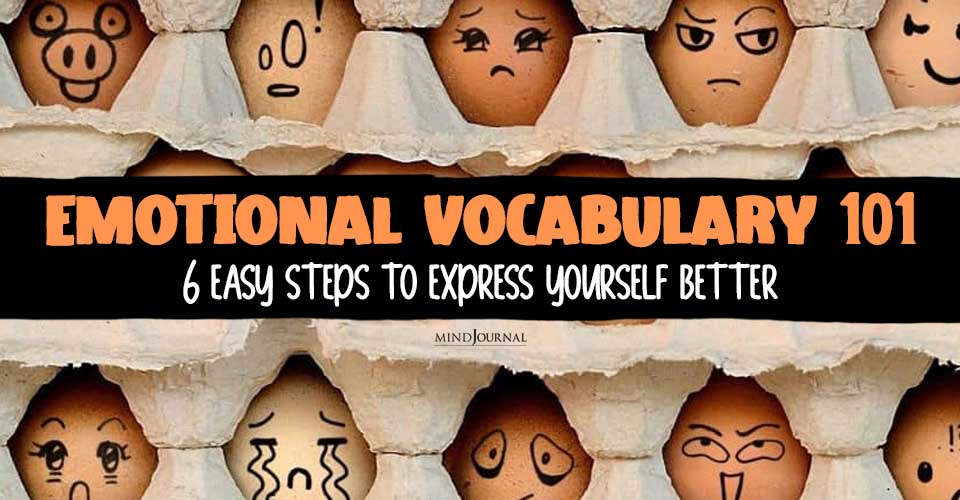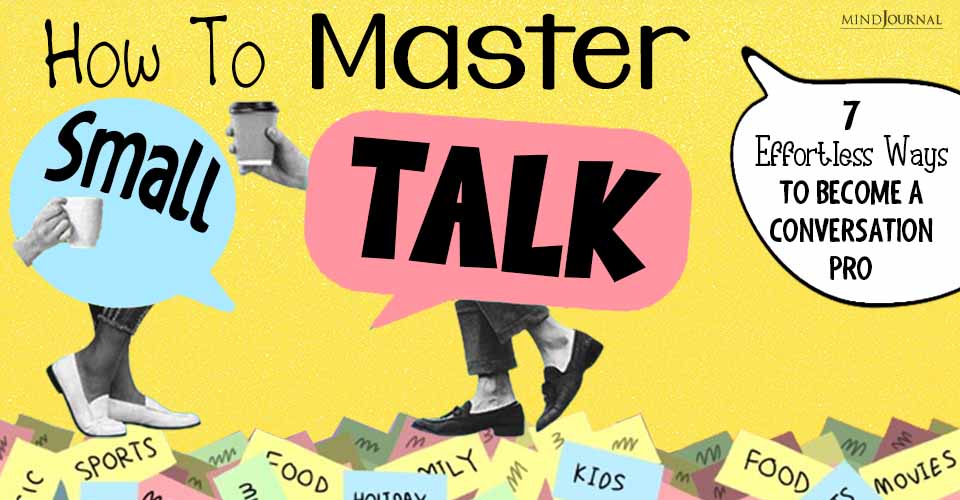Here’s how to get started with the process of reparenting your own inner child.
It is an unequivocal fact that your childhood shaped who you are today.
And no matter how self-aware, loving, and supportive your parents were, it’s also a fact that they passed on their unprocessed emotions and unexamined habits on to you.
So, as you’ve grown from being a child to being an adult, the same unexamined behaviours and habits, and unprocessed emotions are still being carried inside of you.
Enter: reparenting.
Reparenting inner child
Reparenting is a phrase that sounds exactly like what it is: the literal act of reparenting your own inner child.
There are needs that you didn’t get met in your childhood. Needs that, until they are discovered and honoured, will wreak havoc in your adult life. The majority of addicts are simply people who have unprocessed pain, and unmet needs that have yet to be addressed.
Related: How Your Childhood Experiences Define Your Adult Love Styles
And so as long as these unmet needs stay below the level of conscious awareness, we will be drawn towards binge eating, drugs, alcohol, over-working, compulsive exercise, over-spending, video game or internet addiction, and a whole host of other ways that people subtly or overtly numb themselves to their deeper needs.
But if you get in touch with these deeper needs, and take action on them, you will experience a level of freedom and ease that you have yet to enjoy.
You will experience more spontaneous joy, lightness, ease, and flow in your daily life. Life will no longer be monotonous drudgery. The compulsions you used to numb out with will lose their appeal, because you’ll be giving yourself what you actually need.
Not only that, but your relationships will have that much more peace, love, and connection in them. Which would naturally follow. We can only give others what we have practiced giving ourselves. So if you are loving, kind, and emotionally available to all parts of your own psyche, then you will finally be available to be genuinely kind, loving, and emotionally available to your significant other.
So how does one go about the process of reparenting their inner child?
It’s really quite simple. I have three points to make. Let’s get into it.
3 Ways To Reparent Your Inner Child
1. Play more
One of the subtle ways that adults chronically neglect and suppress their inner child is they fill their lives with busy work. Constant errands. Racing from one thing to the next. Layers upon layers of responsibilities.
It’s no wonder that a schedule such as this would leave little to no room for our inner child to feel safe.
Related: Why Healing your Inner Child is Crucial for Self-Growth
So one of the most important preparatory steps you can make is to hold the intention to both create more spaciousness in your life, and to incorporate more play.
As Dr. Stuart Brown once said, “The opposite of play isn’t work, the opposite of play is depression.”
When we leave no room for silliness… playfulness… joy for joy’s sake in our lives, we shrivel up and collapse into ourselves.
So reorganize your values. Shake up your priorities so that you have a regular breathing room in your calendar. Find ways to play and prioritize pleasure and ease in your life, wherever possible.
Play more, and you will already be rebuilding trust with your inner child, which will lay the foundation for the forthcoming deeper reparenting work.
2. Regularly engage in reparenting journalling
If reparenting your inner child is a core focus for you in your inner work lately, then reparenting journalling will be your new best friend.
The exercise has multiple phases, and gets easier and simpler with time.
There are three phases to this practice, the first time that you do it.
First, take out a few sheets of paper. And yes, physically writing it out on paper is far better than writing it digitally (because writing it out with your hand is a slower process, and this is a process that you do not want to rush through).
Now, at the top of the first sheet of paper, write the words, “Inner Child:”. Then, think back to who you were as a child. Anywhere between the ages of 3-10 years old. How did you show up in the world? Who were you at your best? How did you interact with people, and the world around you? Once you have a picture in your mind about your child self, you’ll then write down, in short, bullet-point notes, different character traits that you displayed as a child.
Related: How to Heal Your Inner Child That Is Blocking You For Love
For example, when doing this exercise, I wrote down things like sensitive, trusting, loving, excitable, adventurous, playful, and physically affectionate. So the points don’t have to be long or elaborate, they simply have to be true to you.
(Side note: it is very common for people to feel a welling up of sadness (tears are also common) when tapping into your child self. This is completely normal. Let the emotions move through you. This is the healing already taking place.)
Once you’ve written down anywhere from 5-20 traits, you can move on to the next step.
On a separate piece of paper, or lower down on the same page, you’ll then write “Ideal Inner Adult:”.
Now, think about who you are when you are at your best, today. How do you show up in the world? What are the unique ‘dance moves’ that you bring to every interaction you have with people you like? How do you interact with the world when you are your most relaxed, authentic self?
Again, write down a list of short, bullet-point notes to describe your ideal inner adult. You might write things like calm, confident, generous, loyal, creative, or any other number of traits that feel true for you.
Once you have written down a list of 5-20 things, you’ll move on to the final step of this practice.
Having gotten in touch with these two inner selves, you’ll now be engaging in a slow, intentional conversation between these two parts.
You’ll start (as you always will) with the inner child.
Take a fresh sheet of paper, and write, on the left hand side of the page, “Inner child:”, and then allow him or her to speak to you freely. Allow them to tell you whatever it is they want to tell you.
Related: What You See First In This Image Can Tell A Lot About Your Hidden Inner Self
If you have not been in the practice of checking in with your inner child for any years, the voice might not come to you right away. Which is totally fine. Just as you wouldn’t rush a small child to speak to you in real life, you’re allowed to give your own inner child ample spaciousness to tell you whatever they need to.
Perhaps they want to tell you that they miss playing and want to do it more. Or maybe they want you to know that they’re angry at you for ignoring them for so long. Whatever they want to tell you, it is all welcome.
If you notice that your inner child is speaking in big, heady, multi-syllabic words, then it could be a sign that you aren’t yet truly tapped into your inner child. And you may need to take some deep breaths, move your body, and allow the messages to come through in their own time.
Remember, if the process of getting in touch with your inner child is challenging, that isn’t something to make yourself wrong for. You are doing courageous, important work. And an inner child who is reluctant to speak is simply an inner child that doesn’t yet feel safe to express his or her self. Give them time. There is no rush.
Once your inner child gives you a clear message, it is then time for the “Ideal Inner Adult” to respond. You then have a written dialogue between the two of you, until the session feels like it has reached an ending. There is no correct number of back-and-forths that a session needs to have. Some days it might only be two paragraphs of text, and other days it might be 3, 5, or 10 pages of writing. It is entirely up to you. You do the practice until your inner child feels heard.
So that’s the practice. Get in touch with your inner child, and your inner adult. Then, have them dialogue back and forth on a piece of paper. In future sessions, you don’t need to do the first half of the practice over again… you simply do the dialogue portion and allow these parts to speak to each other.
I generally recommend that when this practice is new to you, there’s value in doing the practice regularly. Some people enjoy doing the practice daily, while others benefit more from doing it a few times per week. The frequency with which you engage in reparenting is up to you. Whatever feels most self-honouring is what will work best.
3. Honour your inner child’s messages to you
Whatever messages your inner child tells you, act on them.
Just like any relationship, sitting down and taking intentional time to listen to the other person’s inner world is important. But if your inner child is telling you what desires they have, then the logical next step is to take action on incorporating what they’re asking for.
Your inner child wants to play more? Incorporate more play. They feel resentful of the type of work you’re doing in the world and want you to make changes in order to prioritize joy over money? There’s something to look into and potentially reorganize your values around.
Personal growth always has two parts: insights, and action.
Related: How Reconnecting With My Inner Child Changed My Life
We honour our inner child when we rest instead of overwork. We honour our inner child when we listen to our bodies, emotions, and energy levels. And we honour them when we take good care of ourselves and practice self-compassion and self-kindness.
Get the insights from your reparenting journalling, and then take action in your life with the insights that you were gifted from your inner child.
Your Life, Post-Reparenting
An adult with an inner child that has been integrated is in an adult with a very strong essence. You can feel their aliveness and vitality in every moment that you engage with them. You can feel, on a deep level, that they are truly friends with themselves.
Incorporate the above three actions into your life, and you will be one of these people. No matter how long it has been since you’ve let your inner child have a say in how you spend your days.
If you would like some personalized help in reparenting your inner child, I would love to help you. And if not, you can simply use the above tools and make progress on your own. Both methods work!
Dedicated to your success,
Jordan
Written by: Jordan Gray
Originally appeared on: Jordan Gray









Leave a Reply
You must be logged in to post a comment.